[English] 日本語
 Yorodumi
Yorodumi- PDB-5nms: Hsp21 dodecamer, structural model based on cryo-EM and homology m... -
+ Open data
Open data
- Basic information
Basic information
| Entry | Database: PDB / ID: 5nms | |||||||||||||||
|---|---|---|---|---|---|---|---|---|---|---|---|---|---|---|---|---|
| Title | Hsp21 dodecamer, structural model based on cryo-EM and homology modelling | |||||||||||||||
 Components Components | (25.3 kDa heat shock protein, chloroplastic) x 2 | |||||||||||||||
 Keywords Keywords |  CHAPERONE / CHAPERONE /  stress response / stress response /  heat shock protein / all-beta greek key heat shock protein / all-beta greek key | |||||||||||||||
| Function / homology |  Function and homology information Function and homology informationchloroplast nucleoid / chloroplast organization / protein folding chaperone complex / response to light stimulus / : / response to heat / regulation of DNA-templated transcription Similarity search - Function | |||||||||||||||
| Biological species |   Arabidopsis thaliana (thale cress) Arabidopsis thaliana (thale cress) | |||||||||||||||
| Method |  ELECTRON MICROSCOPY / ELECTRON MICROSCOPY /  single particle reconstruction / single particle reconstruction /  cryo EM / Resolution: 10 Å cryo EM / Resolution: 10 Å | |||||||||||||||
 Authors Authors | Rutsdottir, G. / Harmark, J. / Koeck, P.J.B. / Hebert, H. / Soderberg, C.A.G. / Emanuelsson, C. | |||||||||||||||
| Funding support |  Sweden, Sweden,  Denmark, 4items Denmark, 4items
| |||||||||||||||
 Citation Citation |  Journal: J Biol Chem / Year: 2017 Journal: J Biol Chem / Year: 2017Title: Structural model of dodecameric heat-shock protein Hsp21: Flexible N-terminal arms interact with client proteins while C-terminal tails maintain the dodecamer and chaperone activity. Authors: Gudrun Rutsdottir / Johan Härmark / Yoran Weide / Hans Hebert / Morten I Rasmussen / Sven Wernersson / Michal Respondek / Mikael Akke / Peter Højrup / Philip J B Koeck / Christopher A G ...Authors: Gudrun Rutsdottir / Johan Härmark / Yoran Weide / Hans Hebert / Morten I Rasmussen / Sven Wernersson / Michal Respondek / Mikael Akke / Peter Højrup / Philip J B Koeck / Christopher A G Söderberg / Cecilia Emanuelsson /   Abstract: Small heat-shock proteins (sHsps) prevent aggregation of thermosensitive client proteins in a first line of defense against cellular stress. The mechanisms by which they perform this function have ...Small heat-shock proteins (sHsps) prevent aggregation of thermosensitive client proteins in a first line of defense against cellular stress. The mechanisms by which they perform this function have been hard to define due to limited structural information; currently, there is only one high-resolution structure of a plant sHsp published, that of the cytosolic Hsp16.9. We took interest in Hsp21, a chloroplast-localized sHsp crucial for plant stress resistance, which has even longer N-terminal arms than Hsp16.9, with a functionally important and conserved methionine-rich motif. To provide a framework for investigating structure-function relationships of Hsp21 and understanding these sequence variations, we developed a structural model of Hsp21 based on homology modeling, cryo-EM, cross-linking mass spectrometry, NMR, and small-angle X-ray scattering. Our data suggest a dodecameric arrangement of two trimer-of-dimer discs stabilized by the C-terminal tails, possibly through tail-to-tail interactions between the discs, mediated through extended IVI motifs. Our model further suggests that six N-terminal arms are located on the outside of the dodecamer, accessible for interaction with client proteins, and distinct from previous undefined or inwardly facing arms. To test the importance of the IVI motif, we created the point mutant V181A, which, as expected, disrupts the Hsp21 dodecamer and decreases chaperone activity. Finally, our data emphasize that sHsp chaperone efficiency depends on oligomerization and that client interactions can occur both with and without oligomer dissociation. These results provide a generalizable workflow to explore sHsps, expand our understanding of sHsp structural motifs, and provide a testable Hsp21 structure model to inform future investigations. | |||||||||||||||
| History |
|
- Structure visualization
Structure visualization
| Movie |
 Movie viewer Movie viewer |
|---|---|
| Structure viewer | Molecule:  Molmil Molmil Jmol/JSmol Jmol/JSmol |
- Downloads & links
Downloads & links
- Download
Download
| PDBx/mmCIF format |  5nms.cif.gz 5nms.cif.gz | 491.9 KB | Display |  PDBx/mmCIF format PDBx/mmCIF format |
|---|---|---|---|---|
| PDB format |  pdb5nms.ent.gz pdb5nms.ent.gz | 420 KB | Display |  PDB format PDB format |
| PDBx/mmJSON format |  5nms.json.gz 5nms.json.gz | Tree view |  PDBx/mmJSON format PDBx/mmJSON format | |
| Others |  Other downloads Other downloads |
-Validation report
| Arichive directory |  https://data.pdbj.org/pub/pdb/validation_reports/nm/5nms https://data.pdbj.org/pub/pdb/validation_reports/nm/5nms ftp://data.pdbj.org/pub/pdb/validation_reports/nm/5nms ftp://data.pdbj.org/pub/pdb/validation_reports/nm/5nms | HTTPS FTP |
|---|
-Related structure data
| Related structure data |  3459MC M: map data used to model this data C: citing same article ( |
|---|---|
| Similar structure data |
- Links
Links
- Assembly
Assembly
| Deposited unit | 
|
|---|---|
| 1 |
|
- Components
Components
| #1: Protein | Mass: 16393.787 Da / Num. of mol.: 6 Source method: isolated from a genetically manipulated source Source: (gene. exp.)   Arabidopsis thaliana (thale cress) / Gene: HSP25.3, At4g27670, T29A15.160 / Production host: Arabidopsis thaliana (thale cress) / Gene: HSP25.3, At4g27670, T29A15.160 / Production host:   Escherichia coli (E. coli) / References: UniProt: P31170 Escherichia coli (E. coli) / References: UniProt: P31170#2: Protein | Mass: 11777.428 Da / Num. of mol.: 6 Source method: isolated from a genetically manipulated source Source: (gene. exp.)   Arabidopsis thaliana (thale cress) / Gene: HSP25.3, At4g27670, T29A15.160 / Production host: Arabidopsis thaliana (thale cress) / Gene: HSP25.3, At4g27670, T29A15.160 / Production host:   Escherichia coli (E. coli) / References: UniProt: P31170 Escherichia coli (E. coli) / References: UniProt: P31170 |
|---|
-Experimental details
-Experiment
| Experiment | Method:  ELECTRON MICROSCOPY ELECTRON MICROSCOPY |
|---|---|
| EM experiment | Aggregation state: PARTICLE / 3D reconstruction method:  single particle reconstruction single particle reconstruction |
- Sample preparation
Sample preparation
| Component | Name: Hsp21 dodecamer, a chloroplast small heat shock protein chaperone Type: COMPLEX / Entity ID: all / Source: RECOMBINANT |
|---|---|
| Source (natural) | Organism:   Arabidopsis thaliana (thale cress) Arabidopsis thaliana (thale cress) |
| Source (recombinant) | Organism:   Escherichia coli (E. coli) Escherichia coli (E. coli) |
| Buffer solution | pH: 8 |
| Specimen | Embedding applied: NO / Shadowing applied: NO / Staining applied : NO / Vitrification applied : NO / Vitrification applied : YES : YES |
Vitrification | Instrument: FEI VITROBOT MARK I / Cryogen name: ETHANE |
- Electron microscopy imaging
Electron microscopy imaging
| Microscopy | Model: JEOL 2100F |
|---|---|
| Electron gun | Electron source : :  FIELD EMISSION GUN / Accelerating voltage: 200 kV / Illumination mode: FLOOD BEAM FIELD EMISSION GUN / Accelerating voltage: 200 kV / Illumination mode: FLOOD BEAM |
| Electron lens | Mode: BRIGHT FIELD Bright-field microscopy Bright-field microscopy |
| Image recording | Electron dose: 1.4 e/Å2 / Film or detector model: DIRECT ELECTRON DE-20 (5k x 3k) |
- Processing
Processing
| EM software |
| ||||||||||||||||||||||||||||||||
|---|---|---|---|---|---|---|---|---|---|---|---|---|---|---|---|---|---|---|---|---|---|---|---|---|---|---|---|---|---|---|---|---|---|
CTF correction | Type: PHASE FLIPPING ONLY | ||||||||||||||||||||||||||||||||
| Particle selection | Num. of particles selected: 33456 | ||||||||||||||||||||||||||||||||
| Symmetry | Point symmetry : D3 (2x3 fold dihedral : D3 (2x3 fold dihedral ) ) | ||||||||||||||||||||||||||||||||
3D reconstruction | Resolution: 10 Å / Resolution method: FSC 0.143 CUT-OFF / Num. of particles: 18407 / Symmetry type: POINT |
 Movie
Movie Controller
Controller


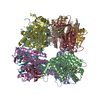
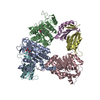
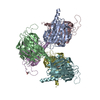
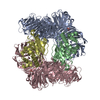
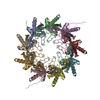
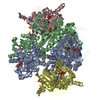
 PDBj
PDBj


